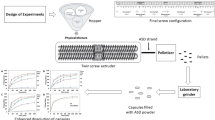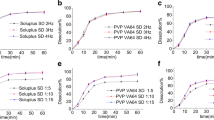Abstract
In a formulation, traces of peroxides in copovidone can impact the stability of drug substances that are prone to oxidation. The present study aimed to investigate the impact of peroxides in novel Plasdone™ S630 Ultra and compare it with regular Plasdone™ S630 on the oxidative degradation of quetiapine fumarate amorphous solid dispersions prepared via hot-melt extrusion technique. The miscibility of copovidones with drug was determined using the Hansen solubility parameter, and the results indicated a miscible drug–polymer system. Melt viscosity as a function of temperature was determined for the drug–polymer physical mixture to identify the suitable hot-melt extrusion processing temperature. The binary drug and polymer (30:70 weight ratio) amorphous solid dispersions were prepared at a processing temperature of 160°C. Differential scanning calorimetry and Fourier transform infrared spectroscopy studies of amorphous solid dispersions revealed the formation of a single-phase amorphous system with intermolecular hydrogen bonding between the drug and polymer. The milled extrudates were compressed into tablets by using extragranular components and evaluated for tabletability. Stability studies of the milled extrudates and tablet formulations were performed to monitor the oxidative degradation impurity (N-oxide). The N-oxide impurity levels in the quetiapine fumarate - Plasdone™ S630 Ultra milled extrudates and tablet formulations were reduced by 2- and 3-folds, respectively, compared to those in quetiapine fumarate - Plasdone™ S630. The reduced oxidative degradation and improved hot-melt extrusion processability of Plasdone™ S630 Ultra make it a better choice for oxidation-labile drugs over Plasdone™ S630 copovidone.









Similar content being viewed by others
References
Wasylaschuk WR, Harmon PA, Wagner G, Harman AB, Templeton AC, Xu H, et al. Evaluation of hydroperoxides in common pharmaceutical excipients. J Pharm Sci. 2007;96:106–16.
Narang AS, Rao VM, Desai DS. Effect of antioxidants and silicates on peroxides in povidone. JPharmSci Elsevier. 2012;101:127–39.
Guideline IHT. Q3B (R2) Impurities in new drug products (2006). The international conference on harmonisation of technical requirements for registration of pharmaceuticals for human use (ICH).
Hovorka SW, Schöneich C. Oxidative degradation of pharmaceuticals: theory, mechanisms and inhibition. J Pharm Sci. 2001;90:253–69.
Tallon MA, Malawer EG, Machnicki NI, Brush PJ, Wu CS, Cullen JP. The effect of crosslinker structure upon the rate of hydroperoxide formation in dried, crosslinked poly (vinylpyrrolidone). Journal of applied polymer science. Wiley Online Library. 2008;107:2776–85.
Ashland | pharmaceutical project report on PlasdoneTM S630 Ultra and PlasdoneTM S630.
Moroni A. A novel copovidone binder for dry granulation and direct-compression tableting. Pharm Technol ASTER PUBL CORP. 2001;25:8–13.
Zecevic DE, Evans RC, Paulsen K, Wagner KG. From benchtop to pilot scale–experimental study and computational assessment of a hot-melt extrusion scale-up of a solid dispersion of dipyridamole and copovidone. International journal of pharmaceutics. Elsevier. 2018;537:132–9.
Baertschi SW, Alsante KM, Reed RA. Pharmaceutical stress testing: predicting drug degradation, Second Edition. CRC Press; 2016.
Koo OMY. Pharmaceutical excipients: properties, functionality, and applications in research and industry. John Wiley & Sons; 2016.
Prachi S, Komal C, Priti MJ. Influence of peroxide impurities in povidone on the stability of selected β-blockers with the help of HPLC. AAPS PharmSciTech. 2017;18:2410–7.
de Diego M, Campos C, Correa D, Mennickent S, Godoy R, Vergara C. Degradation studies of quetiapine fumarate by liquid chromatography–diode array detection and tandem mass spectrometry methods. In: Biomedical Chromatography, vol. 33: Wiley Online Library; 2019. p. e4655.
Trivedi RK, Patel MC. Development and validation of a stability indicating RP-UPLC method for determination of quetiapine in pharmaceutical dosage form. Sci Pharm. 2011;79:97–111.
Just S, Sievert F, Thommes M, Breitkreutz J. Improved group contribution parameter set for the application of solubility parameters to melt extrusion. European Journal of Pharmaceutics and Biopharmaceutics. Elsevier. 2013;85:1191–9.
Verma S, Rudraraju VS. A systematic approach to design and prepare solid dispersions of poorly water-soluble drug. AAPS PharmSciTech. 2014;15:641–57.
Pitt KG, Newton JM, Richardson R, Stanley P. The material tensile strength of convex-faced aspirin tablets. Journal of pharmacy and pharmacology. Wiley Online Library; 1989;41:289–292.
Shang C, Sinka IC, Jayaraman B, Pan J. Break force and tensile strength relationships for curved faced tablets subject to diametrical compression. Int J Pharm. 2013;442:57–64.
Hurley D, Carter D, Ng LYF, Davis M, Walker GM, Lyons JG, et al. An investigation of the inter-molecular interaction, solid-state properties and dissolution properties of mixed copovidone hot-melt extruded solid dispersions. J Drug Delivery Sci Technol Elsevier. 2019;53:101132.
Forster A, Hempenstall J, Tucker I, Rades T. Selection of excipients for melt extrusion with two poorly water-soluble drugs by solubility parameter calculation and thermal analysis. International journal of pharmaceutics. Elsevier. 2001;226:147–61.
Ghebremeskel AN, Vemavarapu C, Lodaya M. Use of surfactants as plasticizers in preparing solid dispersions of poorly soluble API: selection of polymer–surfactant combinations using solubility parameters and testing the processability. International journal of pharmaceutics. Elsevier. 2007;328:119–29.
Maniruzzaman M, Snowden MJ, Bradely MS, Douroumis D. Studies of intermolecular interactions in solid dispersions using advanced surface chemical analysis. RSC advances. Royal Soc Chem. 2015;5:74212–9.
Lu J, Obara S, Ioannidis N, Suwardie J, Gogos C, Kikuchi S. Understanding the processing window of hypromellose acetate succinate for hot-melt extrusion, part I: polymer characterization and hot-melt extrusion. Advances in polymer technology. Wiley Online Library. 2018;37:154–66.
Gupta SS, Solanki N, Serajuddin ATM. Investigation of thermal and viscoelastic properties of polymers relevant to hot melt extrusion, IV: AffinisolTM HPMC HME polymers. AAPS PharmSciTech. 2016;17:148–57.
Gupta SS, Meena A, Parikh T, Serajuddin AT. Investigation of thermal and viscoelastic properties of polymers relevant to hot melt extrusion-I: polyvinylpyrrolidone and related polymers. J Excipients Food Chem Int Pharm Excipients Council Am. 2016;5:1001.
Yang F, Su Y, Small J, Huang C, Martin GE, Farrington AM, et al. Probing the molecular-level interactions in an active pharmaceutical ingredient (API) - polymer dispersion and the resulting impact on drug product formulation. Pharm Res. 2020;37:94.
Solanki N, Gupta SS, Serajuddin AT. Rheological analysis of itraconazole-polymer mixtures to determine optimal melt extrusion temperature for development of amorphous solid dispersion. European J Pharm Sci Elsevier. 2018;111:482–91.
Butreddy A, Bandari S, Repka MA. Quality-by-design in hot melt extrusion based amorphous solid dispersions: an industrial perspective on product development. Eur J Pharm Sci. 2021;158:105655.
Dudhedia MS, Agrawal AM. Rheological study of copovidone and solid dispersion blend used for hot melt extrusion. J Appl Polym Sci. Wiley Online Library. 2016:133.
Ma X, Huang S, Lowinger MB, Liu X, Lu X, Su Y, et al. Influence of mechanical and thermal energy on nifedipine amorphous solid dispersions prepared by hot melt extrusion: preparation and physical stability. Int J Pharm Elsevier. 2019;561:324–34.
Sarode AL, Obara S, Tanno FK, Sandhu H, Iyer R, Shah N. Stability assessment of hypromellose acetate succinate (HPMCAS) NF for application in hot melt extrusion (HME). Carbohydr Polym. 2014;101:146–53.
Li Y, Lu M, Wu C. PVP VA64 as a novel release-modifier for sustained-release mini-matrices prepared via hot melt extrusion. Drug delivery and translational research. Springer. 2018;8:1670–8.
Li M, Gogos CG, Ioannidis N. Improving the API dissolution rate during pharmaceutical hot-melt extrusion I: effect of the API particle size, and the co-rotating, twin-screw extruder screw configuration on the API dissolution rate. International journal of pharmaceutics. Elsevier. 2015;478:103–12.
Butreddy A, Sarabu S, Dumpa N, Bandari S, Repka MA. Extended release pellets prepared by hot melt extrusion technique for abuse deterrent potential: category-1 in-vitro evaluation. Int J Pharm. 2020;119624.
Qian F, Huang J, Zhu Q, Haddadin R, Gawel J, Garmise R, et al. Is a distinctive single Tg a reliable indicator for the homogeneity of amorphous solid dispersion? International journal of pharmaceutics. Elsevier. 2010;395:232–5.
Wani RJ, Sharma P, Zhong HA, Chauhan H. Preparation and characterization of griseofulvin solid dispersions. Assay Drug Dev Technol. 2020;18:109–18.
Gohel MC, Patel TM. Compatibility study of quetiapine fumarate with widely used sustained release excipients. J Therm Anal Calorim. 2013;111:2103–8.
Butreddy A, Sarabu S, Bandari S, Dumpa N, Zhang F, Repka MA. Polymer-assisted aripiprazole–adipic acid cocrystals produced by hot melt extrusion techniques. Crystal Growth & Design. Am Chem Soc. 2020;20:4335–45.
Frank DS, Matzger AJ. Probing the interplay between amorphous solid dispersion stability and polymer functionality. Molecular Pharm ACS Publ. 2018;15:2714–20.
Yuan X, Xiang T-X, Anderson BD, Munson EJ. Hydrogen bonding interactions in amorphous indomethacin and its amorphous solid dispersions with poly (vinylpyrrolidone) and poly (vinylpyrrolidone-co-vinyl acetate) studied using 13C solid-state NMR. Molecular Pharm ACS Publ. 2015;12:4518–28.
Thoorens G, Krier F, Leclercq B, Carlin B, Evrard B. Microcrystalline cellulose, a direct compression binder in a quality by design environment—a review. Int J Pharm. 2014;473:64–72.
Tye CK, Sun CC, Amidon GE. Evaluation of the effects of tableting speed on the relationships between compaction pressure, tablet tensile strength, and tablet solid fraction. Journal of pharmaceutical sciences. Elsevier. 2005;94:465–72.
Abdullah AHD, Putri OD, Fikriyyah AK, Nissa RC, Intadiana S. Effect of microcrystalline cellulose on characteristics of cassava starch-based bioplastic. Polymer-Plastics Technology and Materials. Taylor & Francis; 2020;59:1250–1258.
Patel S, Kou X, Hou HH, Huang YB, Strong JC, Zhang GG, et al. Mechanical properties and tableting behavior of amorphous solid dispersions. J Pharm Sci Elsevier. 2017;106:217–23.
Agrawal A, Dudhedia M, Deng W, Shepard K, Zhong L, Povilaitis E, et al. Development of tablet formulation of amorphous solid dispersions prepared by hot melt extrusion using quality by design approach. AAPS PharmSciTech. 2016;17:214–32.
Iyer R, Hegde S, Zhang Y-E, Dinunzio J, Singhal D, Malick A, et al. The impact of hot melt extrusion and spray drying on mechanical properties and tableting indices of materials used in pharmaceutical development. Journal of pharmaceutical sciences. Elsevier. 2013;102:3604–13.
Maincent J, Williams RO. Sustained-release amorphous solid dispersions. Drug Deliv and Transl Res. 2018;8:1714–25.
Hamed R, AlJanabi R, Sunoqrot S, Abbas A. The effect of pH, buffer capacity and ionic strength on quetiapine fumarate release from matrix tablets prepared using two different polymeric blends. Drug Development and Industrial Pharmacy. Taylor & Francis; 2017;43:1330–1342.
Júlio TA, Zâmara IF, Garcia JS, Trevisan MG Compatibility and stability of valsartan in a solid pharmaceutical formulation. Brazilian Journal of Pharmaceutical Sciences. Faculdade de Ciências Farmacêuticas da Universidade de São Paulo; 2013;49:645–651.
Wu Y, Levons J, Narang AS, Raghavan K, Rao VM. Reactive impurities in excipients: profiling, identification and mitigation of drug–excipient incompatibility. AAPS PharmSciTech. 2011;12:1248–63.
Funding
This work was partially supported by the National Institute of General Medical Sciences (NIGMS), a component of the National Institutes of Health (NIH) as one of its Centers of Biomedical Research Excellence (COBRE), under Grant Number P30GM122733-01A1.
Author information
Authors and Affiliations
Corresponding author
Additional information
Guest Editors: Harsh Chauhan and Robert (Bill) Williams III
Publisher’s Note
Springer Nature remains neutral with regard to jurisdictional claims in published maps and institutional affiliations.
Rights and permissions
About this article
Cite this article
Butreddy, A., Sarabu, S., Bandari, S. et al. Influence of Plasdone™ S630 Ultra—an Improved Copovidone on the Processability and Oxidative Degradation of Quetiapine Fumarate Amorphous Solid Dispersions Prepared via Hot-Melt Extrusion Technique. AAPS PharmSciTech 22, 196 (2021). https://doi.org/10.1208/s12249-021-02069-9
Received:
Accepted:
Published:
DOI: https://doi.org/10.1208/s12249-021-02069-9




